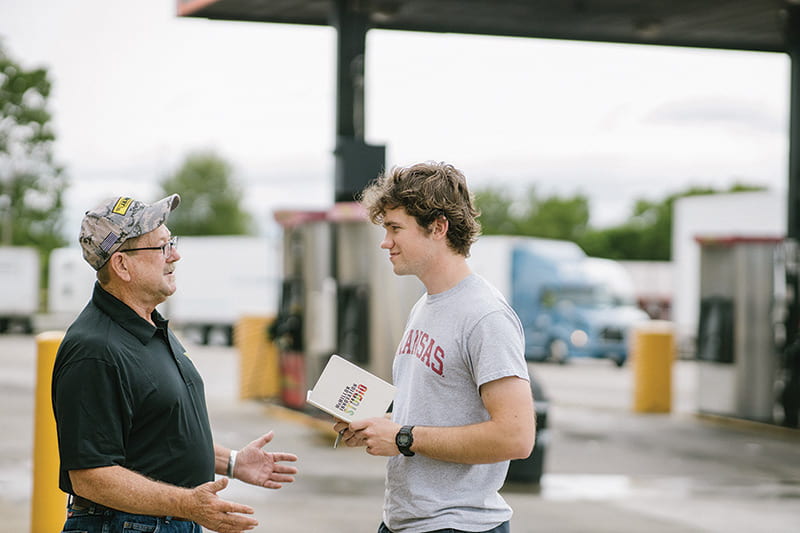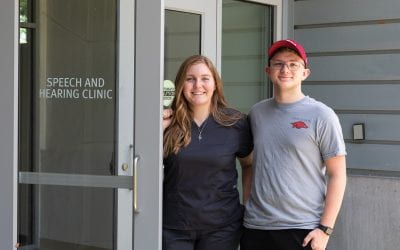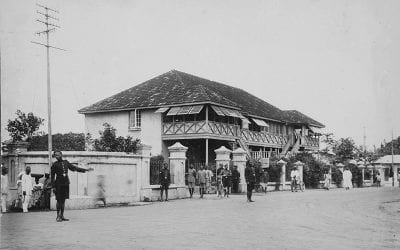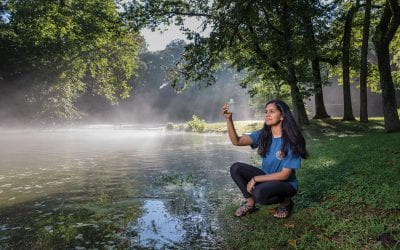
Nick Foster, Lauren Horne, Colby Reed and Robbie Prettyman examine the prototype for a laser lighting system in the McMillon Innovation Studio.
Driving Innovation
By Kendall Curlee
Photos courtesy of Philip Thomas
Truck drivers keep our economy moving and currently, they’re in short supply. The driver shortfall has tripled from 20,000 in 2005 to more than 60,000 in 2018, according to a recent analysis. What’s driving the flight from an industry that’s central to Arkansas’ economy? An interdisciplinary team of students led by Nick Foster, an Honors College Fellow majoring in supply chain management, decided to find out.
Foster’s team was participating in Walton College’s McMillon Innovation Studio, where students are challenged to consider stubborn problems and come up with creative solutions. “As a whole the studio seeks to create ‘customer-centric’ design — everything relates back to user experience,” Foster said. So the students started by interviewing more than 100 truck drivers at the Pilot Travel Center on Highway 412.

Nick Foster’s team went the extra mile to research and develop new solutions for truck drivers — starting with 100+ interviews at a Springdale truck stop.
“They’re hardworking, they take pride in what they do and they’re the backbone of an unglamorous industry,” Foster said. Drivers face problems ranging from strict regulations on hours of service to a scarcity of rest stops where they can pull over for the requisite downtime. But the greatest stressor, the students found, was other drivers. “The root cause of a lot of the problems are passenger vehicles on the road,” said Lauren Horne, an honors supply chain management major who frequently joined Foster to conduct interviews. “They’re tailgating, riding in blind spots and cutting them off.” While ignorance may be part of the problem, with car drivers not knowing a truck’s blind spots or braking distance, there’s also “a bit of disregard for the fact that there’s a human being in the truck,” Horne said.
The students looked to lasers to create light systems that could educate car drivers, by displaying a truck’s braking distance, for example. At this point, the interdisciplinary nature of the team proved useful, with engineering students Robbie Prettyman and Colby Reed fabricating prototypes with 3-D printers, while Lucinda Williams and Alayna McGary, both pursuing careers in the medical field, focused on driver behavior. “That was the greatest benefit: a big-picture, phenomenal opportunity to work cross functionally and learn the value of doing so,” Horne said.
During the prototyping phase, “we created as many things as possible, not worrying if they’re ridiculous,” Foster said. There were strict regulations to contend with: red and blue lights, for example, are reserved for emergency vehicles, and they had to take care with placement of the device so that light would not beam directly into a passenger car’s rearview mirror. “We ended up going with a field of light rather than a harsh light, and we went with green,” Horne said. “But can you see it during the day?” As they contended with these issues, the students were able to work closely with truck carriers such as J.B. Hunt and A.B.F. “Arkansas has a really rich heritage in trucks and transportation, and it’s been great to drill into that,” Foster said.
Horne’s father, a truck driver with a small, family-owned company in Northwest Arkansas, also provided feedback. “When we prototyped something, my dad let us — not mount, but almost like pretend to mount it on his truck that he brought home from work one day,” Horne recalled. “He gave us a lot of input and … on the road the next day he’d think of something else and text me and say, ‘why don’t you think about this, or tell Nick I thought about this,’ so he was very helpful to us.”
Their prototype did spark industry interest, but the students on the team ultimately moved on to other projects and courses. Still, Horne is hopeful that someone will pick up on their idea and run with it. “Passenger cars have had backup cameras and blind spot monitors for years now, and the fact is that trucks are transporting billions of dollars in cargo each year and are not nearly as technologically advanced.”
This group project received funding support from Power Technology Inc., Little Rock.
“As a whole the studio seeks to create ‘customer-centric’ design — everything relates back to user experience.”
More Field Notes
Band Aid
By Hiba TahirPhotos courtesy of Russell Cothren Emily Myers, a trumpet player in the Razorback Marching Band, looked around during a high school warm-up one day years ago to discover that — despite an alarmingly high decibel level that “maxed out” an app she used to...
Linking Fate + Future
By Katie Wilson PowellPhotos courtesy of Russell Cothren When it comes to politics, what impacts your opinions? When you fill out your race or ethnicity on the census, do you struggle with which box to check? These are key questions that Esmeralda Verdin Gomez...
Exploring National Identity By Design
By Brock DeMark Photos courtesy of Jim Tschetter/IC360 Images and Russell CothrenHonors architecture major Anna Ibru grew up in Lagos, Nigeria, in a neighborhood graced by many colonial-era bungalows on expansive lots. “My whole life revolved around buildings like...
Probing Pollution at Lake Keith
By Samantha Kirby Photos courtesy of Russell Cothren and Chieko Hara If you’ve ever traveled along Highway 112 to Northwest Arkansas National Airport, you’ve likely passed Lake Keith on your way through Cave Springs. But you can’t be faulted for not noticing: On...





